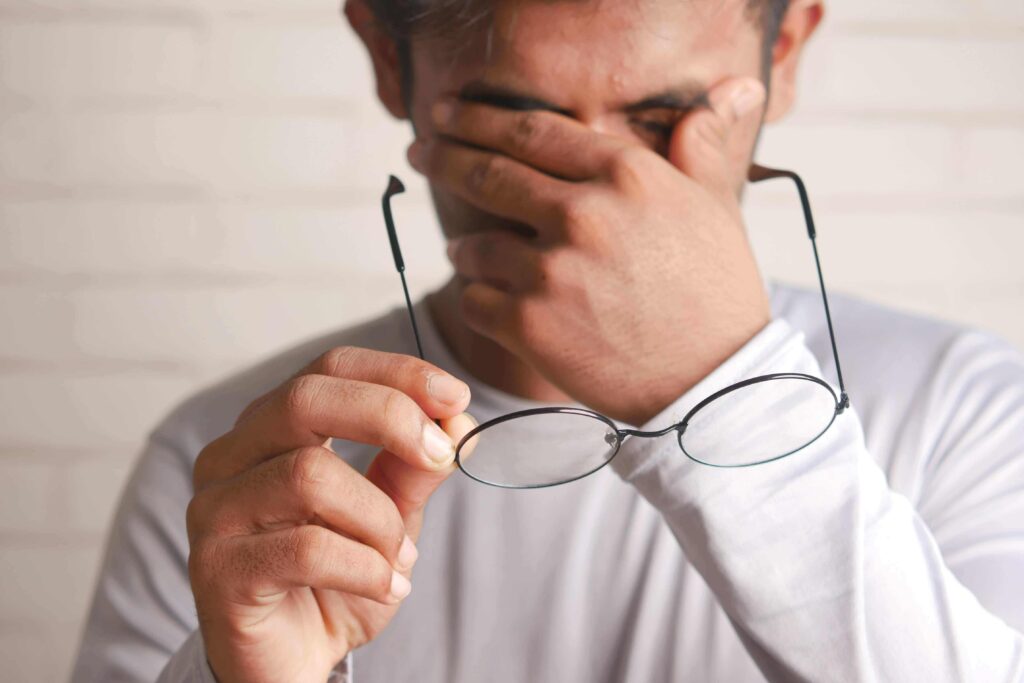
More than two-thirds of American adults wear some kind of prescriptive eyewear, including glasses, contacts, or prescription sunglasses. While you can purchase reading glasses over the counter at many drug stores, these corrective lenses are not suitable for all vision problems. For your clearest vision and minimal eye strain, you’ll want to get a prescription from your eye doctor, also called an ophthalmologist.
What do all these abbreviations mean?
If your eye doctor determines you need a prescription for eyeglasses or an update to your current prescription, they will hand you a chart that looks something like this:
Prescription eyeglass lenses are custom-crafted for your eyes and take into account things like shape and degree of correction needed. This chart is a simple way for the doctor to convey all necessary information to the person making your lenses. While shorthand and abbreviations are more convenient for professionals, they can be confusing for patients. We’ll break down what each section of the chart means so you can understand your prescription and how best to take care of your eyes.
Left vs. Right
You might notice that the rows of the column are divided into two groups, and each group is divided into the same two subsections: OD and OS. This helps the doctor and the lens maker distinguish between your two eyes since it’s possible for each eye to have its own shape and prescription strength.
The abbreviations are Latin, where oculus dexter (OD) stands for “right eye” and oculus sinister (OS) stands for “left eye.” Sometimes, you may see OU for oculus uterque, which means “both eyes”.
Nearsighted vs. Farsighted
In the first empty column (and sometimes the second, but we’ll get to that later), you’ll see a number between 0.00 and 6.00. The number will be preceded by either a plus sign (+) or a minus sign (-). These numbers represent the amount of vision correction required in each eye to help you see clearly, measured in diopters. A diopter is a unit that measures the refractive power of a lens.
The higher the number is, the more help your eyes need to see clearly. The plus and minus signs represent whether you are nearsighted (myopia) or farsighted (hyperopia). A nearsighted person will have trouble seeing things at a distance, such as a blackboard at the other end of the classroom. A farsighted person has trouble seeing something close to them, like words in a book they are holding in front of their face.
Astigmatism
You might have noticed that the first two blank columns are labeled sphere (SPH) and cylinder (CYL). When we talked about nearsightedness and farsightedness, we focused on how they affect the sphere column. However, you might also see measurements in diopters in the cylinder column—but not always. Why?
Ideally, your cornea and lens should be perfectly spherical. However, this isn’t always the case. If your eye does not have a perfectly spherical curvature, you have a condition called astigmatism that requires cylindrical correction. If you don’t have astigmatism, you won’t see a number in the cylinder column. However, even if you do have astigmatism, you will always see a number in the sphere column.
If you do have a number in the cylinder column, it will always be accompanied by a number in the next column, titled Axis. Instead of diopters, the number you see in the Axis column represents degrees from 1 to 180.
This is a measurement of the lens meridian that requires cylindrical power to correct the astigmatism. A 90 axis means that the vision correction should be applied in a perfectly vertical position; closer to 1 or 180 indicates horizontal positioning.
Additional Magnification
In the sphere column, there are two additional rows grouped together as ADD. This stands for “additional magnification.”
Even if you are naturally nearsighted, most people will develop a certain degree of farsightedness with age, called presbyopia. When this happens, you may need bifocal or multifocal lenses to help you see and read clearly at all distances.
Multifocal lenses have different corrective properties along different areas of the lens. Usually, the part of the lens that compensates for presbyopia is somewhere in the bottom half of the lens. The diopter measurements under ADD represent how strong this part of the lens needs to be.
Prism
The final columns are called prism and base, and they are also related. Your eyes should move in alignment. However, if you have strabismus or amblyopia—commonly called crossed eyes or a lazy eye—this may not always be the case. Eye misalignment can cause double or blurry vision.
To correct it, your doctor can add a prism to your lenses. The strength of the prism required to correct your vision is measured in prism diopters in metric, or fractional English units in the prism column. The prism itself will be triangular.
The base column tells the lens maker where to position the base to correct vision properly. BU stands for “base up” and means the base should be in the direction of your eyebrow. BD means “base down,” indicating the base should point in the direction of your cheekbone. BI (base in) tells the lens maker to position the base toward your nose, while BO (base out) means toward your ear.
What about contact lenses?
If you prefer contact lenses to eyeglasses, you will need to get a second prescription from your doctor.
Your contact lens prescription and eyeglasses prescription may not match exactly. Unlike your glasses, which allow for some distance between your eyeball and the lens, contacts sit directly on your eyeball. This can affect how much refraction power is needed.
Contact lenses can’t be customized the same way eyeglass lenses can, so your doctor may also need to adjust your prescription slightly to match the manufacturers’ parameters.
Since the contact lens will sit directly on your eyeball, it needs to fit perfectly. Your contact prescription should include a measurement of the base curvature (BC) of your eye between 8 to 10 millimeters and the diameter (Dia) of your pupil. The diameter can vary more than the base curvature, but it will usually be between 13 to 15 millimeters.
On your contact prescription, your doctor will also include what brand you have been prescribed and when your prescription expires.
Of course, you do have options to see clearly without glasses or contacts. Schedule a consultation with the Atlanta Vision Institute to see if you’re a candidate for laser eye surgery. An added bonus is that getting Lasik saves money long-term for you.
How often do I need to see my eye doctor?
Most people’s eyes continue to change as they age. In addition to age-related presbyopia, some people may develop cataracts, glaucoma, and macular degeneration later in life. Seeing an eye doctor regularly can help catch these conditions early and prevent vision loss.
The American Optometric Association recommends that most adults under age 65 get their eyes checked at least every two years. After 65, you should start visiting your eye doctor annually.

Please Take Our LASIK or Cataract Surgery Quiz
Take our vision quiz to find out if you qualify for LASIK or cataract surgery!



